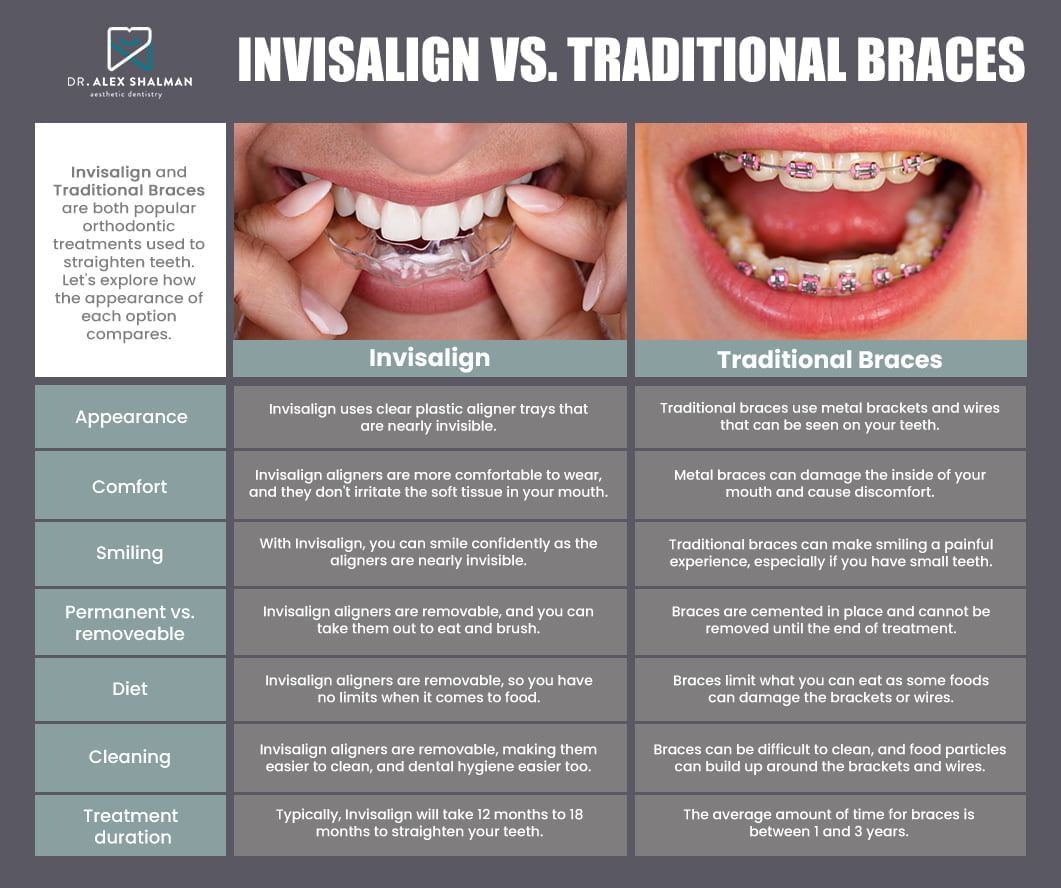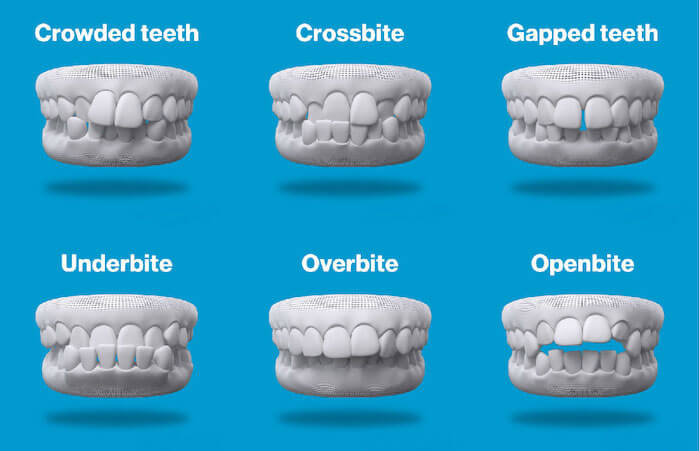How Invisalign Functions: Your Guide to Clear Aligners and Their Effectiveness
How Invisalign Functions: Your Guide to Clear Aligners and Their Effectiveness
Blog Article
Invisalign vs. Typical Dental braces: Which Alternative Is Right for You?
When considering orthodontic treatment, the option between Invisalign and standard braces provides a number of important elements that warrant cautious assessment. Invisalign provides a discreet option with removable aligners, while standard braces supply a more noticeable yet efficient option for serious misalignment.
Review of Treatment Alternatives

On the other hand, conventional braces contain steel brackets and cords that are bonded to the teeth. This technique uses continuous stress gradually to attain positioning. While effective for complex orthodontic concerns, traditional braces call for regular gos to for adjustments and can pose obstacles in maintaining dental health due to the problem of cleaning up about cords and brackets.
Both alternatives have their advantages, and the option usually hinges on certain dental problems, lifestyle choices, and individual conformity. Eventually, seeking advice from an orthodontic specialist is essential for determining the most suitable therapy plan customized to specific requirements. Understanding the nuances of each option can considerably affect the general success of orthodontic therapy.
Visual Factors To Consider
A substantial element influencing the choice between Invisalign and traditional braces is the visual appeal each treatment supplies. Invisalign aligners are crafted from clear plastic, making them virtually invisible when worn. This very discreet appearance is especially interesting adults and teenagers that might feel self-conscious concerning their orthodontic treatment. The ability to preserve a natural smile throughout the alignment procedure can substantially improve the patient's self-confidence in social and professional setups.
In contrast, conventional dental braces include steel brackets and cords, which can be a lot more recognizable. While innovations in orthodontic technology have led to the growth of smaller sized brackets and colored elastics, traditional braces still keep a more obvious account. For some individuals, the presence of braces may hinder them from seeking needed therapy.
Eventually, the choice in between Invisalign and standard dental braces may pivot on personal choices relating to appearances. Patients who focus on discretion often favor Invisalign, while those that are less worried concerning visibility may choose standard braces. Comprehending the aesthetic implications of each choice is crucial for making a notified choice that lines up with one's lifestyle and choices.
Convenience and Convenience

In terms of benefit, Invisalign aligners are detachable, allowing people to enjoy their favored foods without constraint and keep optimal dental hygiene. Cleaning and flossing are streamlined, as the aligners can be taken out during these routines, whereas conventional dental braces require mindful navigating around brackets and cords.
In comparison, standard braces necessitate regular adjustments, making them less practical for those with active routines. Overall, the convenience and benefit of Invisalign make it an attractive choice for numerous people seeking orthodontic treatment.
Therapy Period and Effectiveness
While both Invisalign and conventional braces work in fixing oral misalignments, the period of therapy can differ considerably in between the 2 alternatives. Typically, Invisalign treatment can take anywhere from 12 to 18 months, depending upon the complexity of the case. The clear aligners work by slowly moving teeth right into their desired placements, and normal follow-ups with an orthodontist help ensure progression stays on track.
In contrast, typical braces frequently need a longer commitment, generally varying from 18 months to 3 years. This is due to their fixed nature and using braces and cords, which can be extra effective for extreme misalignments and complex instances (Invisalign). The treatment efficiency of standard dental check out here braces is well-documented, as they enable accurate changes and greater control over tooth activity
Inevitably, the option between Invisalign and traditional braces might hinge on both the awaited treatment period and the certain dental problems at hand. Consulting with an orthodontist is crucial, as they can give tailored suggestions based on specific needs, ensuring the picked technique lines up with preferred outcomes and durations.
Expense Contrast and Insurance Choices
Price plays a significant function in the decision-making process for individuals considering orthodontic therapy, whether selecting Invisalign or typical braces. Usually, the price of Invisalign ranges from $3,000 to $8,000, while standard braces typically cost between $2,000 and $6,000. Factors affecting these expenses consist of the complexity of the situation, the duration of therapy, and geographical area.
Insurance policy coverage can significantly influence out-of-pocket costs. Many dental insurance coverage strategies supply partial protection for orthodontic treatments, but the specifics can differ commonly. It is critical for patients to evaluate their insurance plan to figure out the degree of protection for either option. Usually, traditional braces might be more frequently covered by insurance plans contrasted to Invisalign, which some insurance providers classify as a cosmetic treatment.
In addition, several orthodontic practices supply adaptable layaway plan, making both treatment alternatives much more easily accessible. People should inquire regarding potential funding alternatives and discount rates for upfront repayments. Reviewing the overall cost, including insurance policy advantages and layaway plan, is vital for making an educated choice that aligns with both visual choices and spending plan considerations.

Final Thought
In recap, the selection in between Invisalign and standard dental braces hinges on numerous elements, consisting of visual preferences, comfort, treatment duration, and expense. Invisalign provides a very discreet, detachable option that helps with oral health and nutritional versatility, while conventional braces may be preferable for complicated oral concerns and commonly come with a reduced rate factor. Inevitably, assessment with an orthodontist is vital to analyze private scenarios and determine the most appropriate treatment alternative for accomplishing ideal oral placement.
When thinking about orthodontic treatment, the selection between Invisalign Home Page and standard dental braces offers several vital variables that warrant cautious examination.Comparing Invisalign and traditional braces discloses distinctive therapy choices for orthodontic adjustment.While both Invisalign and typical braces are reliable in fixing dental imbalances, the duration of therapy can vary considerably between the 2 alternatives.Price plays a significant role in the decision-making procedure for individuals considering orthodontic dig this treatment, whether deciding for Invisalign or conventional dental braces.In summary, the selection in between Invisalign and standard dental braces hinges on several elements, including aesthetic choices, convenience, therapy period, and price.
Report this page